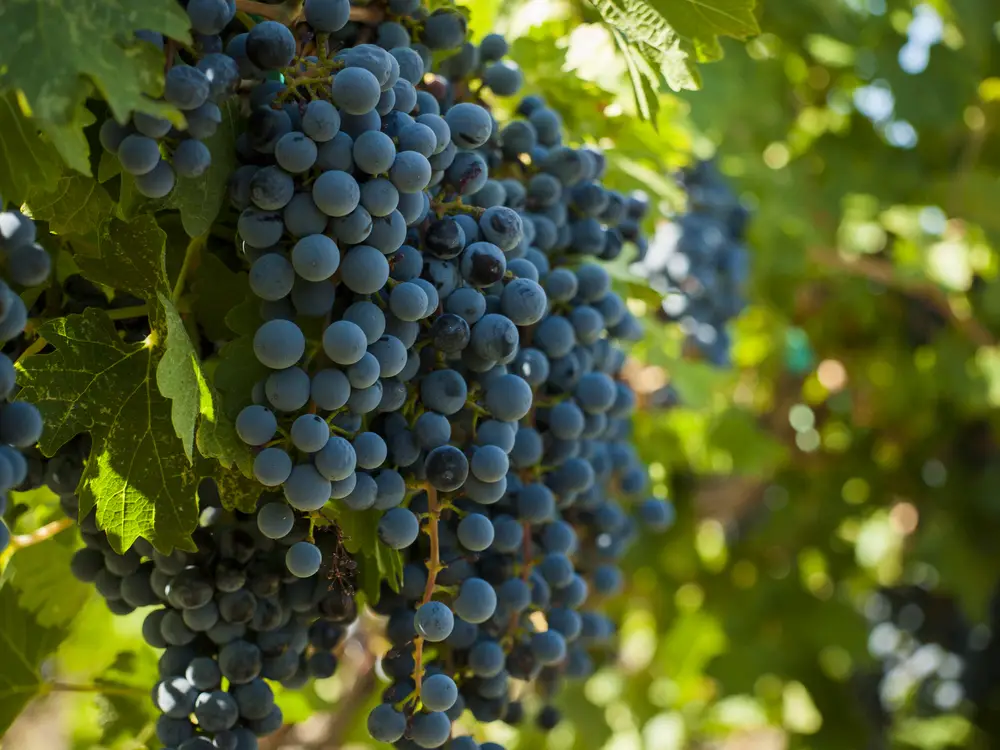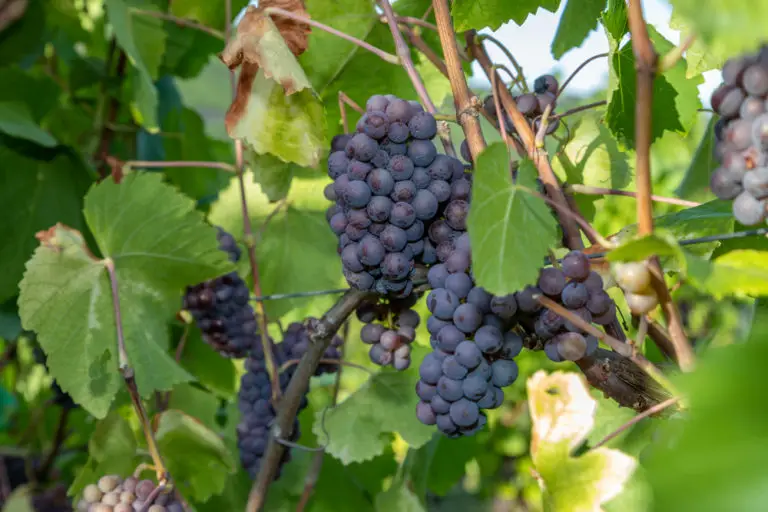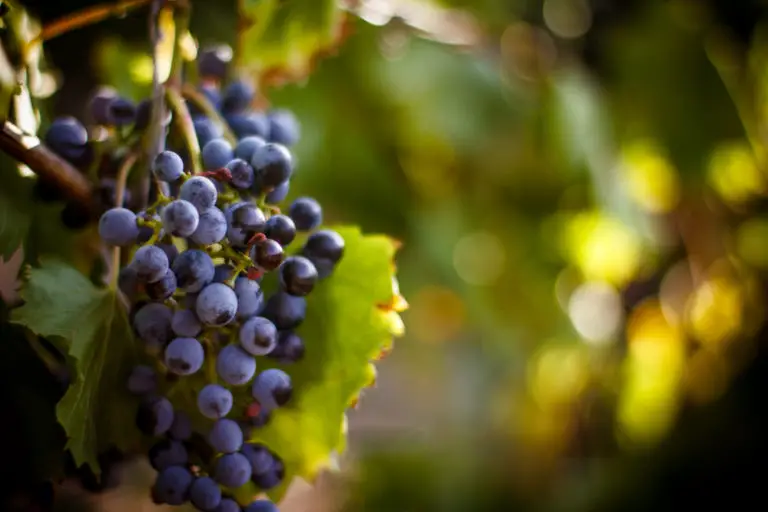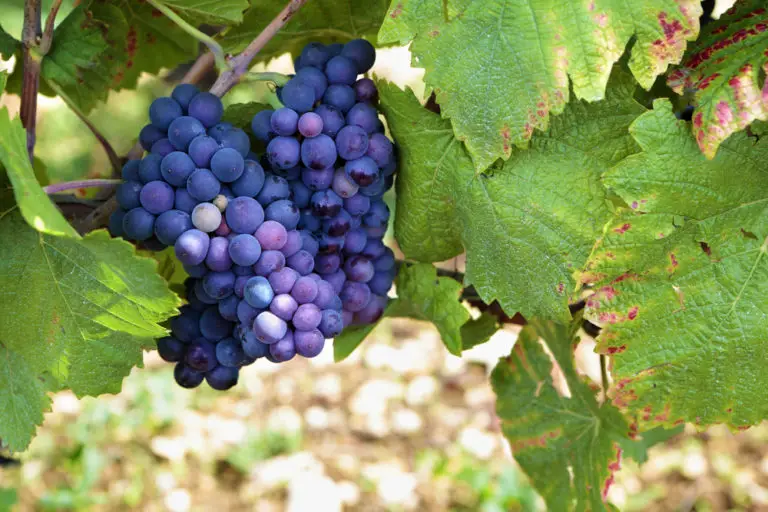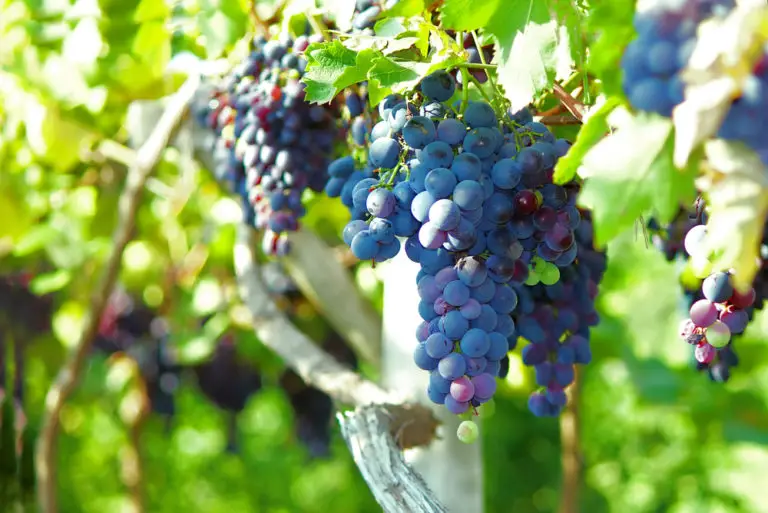Petit Verdot: The Beginners Guide (2024)
Petit Verdot is an autochthonous red grape variety from southwest France. Originally, it played a role primarily in classic Bordeaux cuvées from the Medoc, where the variety was often used as an acidic and coloring component to give the wines more strength and longevity. Because of the small size of the grapes, the tannin content of this wine is very high.
Wine Color: Deep intense reddish-purple
Characteristics: Full body, High-tannin, Medium Acidity
Color of berry skin: Rouge
Flavor: Dry
ABV: 13.5–15%
Origin: France, South West France
Notable Regions: Bordeaux, Australia, Argentina, California, Virginia
Most Expensive Bottle: Abadia Retuerta P V Petit Verdot Vino de la Tierra de Castilla y Leon, Spain
Common synonyms: Bouton, Carmelin, Petit Verdau, Petit Verdot Noir, Verdot and Verdot Rouge
- What is Petit Verdot?
- Known Regions for Petit Verdot
- Popular Blends of Petit Verdot
- How to Enjoy Petit Verdot?
- How is Petit Verdot Made?
- History of Petit Verdot
- Alternatives for Petit Verdot
What is Petit Verdot?
The red grape variety Petit Verdot is one of the classic Bordeaux varieties. It is also known by other names such as Bouton Blanc, Carmelina, Héran, or Verdot Rouge. Pure Petit Verdot red wine is very acidic and contains tannins, which is why only small proportions of this variety are usually used in the blend. Château Margaux or Château Latour are popular blends of this wine. Petit Verdot pronunciation is peh-TEE vehr-DOH.
In the 19th century, the cultivation of this red wine was widespread in France. However, a decline in the population has been observed for years. The wine ripens late and is now mainly cultivated in the Bordeaux wine-growing region (especially in Margaux). In addition, the vine is grown in South Australia, Chile, South Africa, California, New Zealand, Argentina, Spain, Portugal, or other hot countries.
The main noticeable feature of the Petit Verdot varietal is the late-ripening. The name Petit Verdot, which means something like “small green compact”, already indicates that the grapes rarely reach full ripeness.
Petit Verdot vs. Petite Sirah vs. Cabernet Sauvignon
Petit Verdot vs Petite Sirah is two completely different types of variety. Petit Verdot has higher acidity as compared to Petite Sirah and has lesser alcohol content. Also, Petit Verdot is less fruity, having dominant flavors of black cherry, plum, violet, lilac, and Sage. While, Petite Sirah is fruitier, having flavors of Black pepper, Black tea, dark chocolate, blueberry, and sugar plum.
The dry Petit Verdot is grown in many regions like Spain, Australia, France, the United States, and Italy. Petite Sirah, on the other hand, is widely grown in the regions of the United States and Australia.
Petit Verdot vs Cabernet Sauvignon are unrelated but are often blended. Petit Verdot is responsible for adding color and tannins to the wine when blended with cabernet sauvignon. They favor the same gravelly soils and climate, therefore, it is often grown in the same area of Spain, France, and Australia.
Petit Verdot Characteristics
The Petit Verdot grape variety produces tannic, spicy wines with aromas of violets and fruit. The grape owes its name “small green compact” to its considerable acidity and the thick skins, which provide a lot of tannins. Due to its long vegetation cycle, it takes a long time to mature. If it is harvested too early, it is less digestible.
Both in the bottle and the wine glass, Petit Verdot beguiles with its strong, dark red tone. In addition to a high tannin and acid content, the high Petit Verdot alcohol content is characteristic of the wine. A Petit Verdot wine has very good storage potential, as it has a long shelf life due to the high concentration of tannins and acids. If it is properly stored in the wine cellar, it can mature for many years.
The Petit Verdot grapes are often used for cuvées. A cuvée with Petit Verdot characteristics is definitely stronger. The grape enriches the mix of varieties with its high tannin and acid content.
Petit Verdot Taste Profile
The Petit Verdot color is dark, almost black, concentrated, and brilliant. The bouquet is original, with pronounced balsamic notes, a hint of anise, mint, and chocolate (After Eight) without green vegetable notes. The approach on the palate is determined, balanced, and intense but never aggressive. The fruit is well integrated and ripe. The fresh acidity of this red wine is stimulating and pronounced.
The tannins are lush, sweet, and spicy, and the finish of this red wine develops extensive, in-depth with hints of balsamic and spicy aromas. A wine that, despite its young age, is already balanced and presented with an interesting personality.
When aged in wood, the Petit Verdot taste is influenced by intense notes of red fruits, plums, and blackberries combined with other complex aromas of caramel, vanilla, and mocha. On the palate, they are fatty and meaty, with great breadth. They are balanced in acidity and sweet tannins.
Petit Verdot Ageability
The aging of wine occurs naturally and takes place only after it has been bottled. In wine, aging is referred to as a positive process that improves the quality of the wine. The opposite can only occur sometimes if the fermentation lasts too long and makes the wine inedible.
The period of aging describes the total time between the completed fermentation and the point in time at which the wine has become inedible. Of course, this is also where the art of the winemaker lies.
Through aging, he wants the wine to optimize its aromas, smell, and texture through chemical reactions and thus achieve positive bottle aging. These reactions are set in motion by the sugar, the acids, and the phenols; they ultimately give the wine its bouquet.
Petit Verdot can comfortably cellar for 10 years or more as the tannins slowly soften.
Notable Regions for Petit Verdot
Originally from the Bordeaux area, Petit Verdot is now marginally used in the production of the red wines of that area. Not only there, but the Petit Verdot name is also now widely planted in many other regions of Australia, France, Peru, the United States, and Spain.
Peru
In Peru, Petit Verdot vines are cultivated in the southern region of Ica. Ica’s desert climate allows producers to make 100% varietal Petit Verdot wines. The Tacoma winery produces one of its high-end wines, “Don Manuel” with 100% Petit Verdot grapes.
United States
The more consistent and warmer climate of areas here accelerates ripening the grape, and growers are starting to experiment with unique varieties. It is also planted in Arizona, Colorado, Oregon, Texas, Michigan, Virginia, Maryland, Missouri, North Carolina, New Jersey, Pennsylvania, Long Island, New York, New Mexico, and Washington.
Spain
Petit Verdot regions in Spain are mainly Jumilla, Almansa, Mentrida, and Castilla La Mancha in Spain. These regions offer many of the single varietal wines, which are opaque in color which are often high in tannins. They mostly have notes of black pepper, black fruits, licorice, and clay-like minerality.
France
Almost all Petit Verdot in France is grown in Bordeaux, mainly in Médoc, where it is used in small quantities to give structure to the classic Bordeaux blend. However, late-maturing means that in a few years the entire vintage is lost, and it only ripens properly once every four years. So it has fallen out of favor, especially with the trend towards earlier maturing wine.
Australia
Verdot was included in James Busby’s 1832 collection and was tested by Sir William Macarthur in the 1840s. In 2000, there were 1,600 hectares in Australia with Kingston Estate in South Australia having the largest planting, four times as much as in France. There are a lot of Petit Verdot single varietal wines sourced from South Australia, and excellent examples can be found around the Barossa Valley and McLaren Vale.
Popular Blends of Petit Verdot
The term “blend” or “blend” in its original meaning refers to any combination of wine grape varieties. It is used to make the wine taste richer and brighter, as well as to give aroma and texture to the drink. Here are some popular Petit Verdot blends that you must try:
Buezo Petit Verdot
This wine is a blend of 50% Tempranillo and 50% Petit Verdot alcohol percentage. It is a dry wine having great acidity and perfect balance. After a smooth entry, it is well structured and broad, somewhat mineral. The tannins are perfectly polished. After the drink (powerful and sweet), it leaves a long memory with good persistence, appearing the aromas of white pepper, toasted and chocolates in liquor through the retronasal route.
Creation Merlot – Cabernet Sauvignon – Petit Verdot 2014
The color of Creation Merlot- Cabernet Sauvignon- Petit Verdot abv shines in a deep dark red with black reflections in the glass. Its scent is reminiscent of juicy aromas of ripe cherries paired with crunchy plums. The red wine scores with its elegant and full-bodied streak and long finish.
Jean Leon Merlot – Petit Verdot DO 2019
This wine shows an intense ruby red with purple reflections. Its bouquet is determined by sour cherries, red berries, and ripe forest berries. Root nuances of oak, cinnamon, and juniper as well as some earthy-mineral nuances complement. On the palate, the Jean Leon Merlot – Petit Verdot is fantastically elegant, fresh, and fruity.
2015 Summa Varietals
This red dry blend has a pleasant floral bouquet with notes of violets and delicate toast and chocolate aromas. Fruity, fleshy, and harmonious on the palate, well-embedded soft tannins. A charmer par excellence, a palate flatterer, a perfect soloist: a modern Spaniard with plenty of drinking flow. Smooth, round, and elegant! It is a blend of Syrah, Petit Verdot, Cabernet Sauvignon
2017 ‘Circle Of Life’ Red Trocken
It is a Red dry blend with lush aromas of ripe fruit and vanilla coconut notes on the palate. It shows its stunning depth and impressive intensity. Goes well with hearty stews, venison steak with autumn herbs, lamb, pasta with tomatoes, and grilled aubergines with parmesan. It is a blend of Syrah, Petit Verdot, Merlot, and Cuvée Rot.
How to Enjoy Petit Verdot?
Following some basic wine recommendations can make the taste of the wine more interesting. It can bring out the best aromas and Petit Verdot flavor. Here are some food pairing recommendations, optimal serving temperature details, and stemwares that you must use to enjoy a glass of Petit Verdot.
Food Pairings
The Petit Verdot produces a wine with an intense flavor that can be accompanied by numerous main courses. Red meats, stews are perfect to be enjoyed with a good glass of wine produced by the Petit Verdot to enhance the flavor of the food and make the experience truly sensorial. The younger Petit Verdot alcohol is also excellent as an accompaniment to aged cheeses and cured meats such as Sopressa Vicentina. Here is some Petit Verdot wine pairing:
- Red Meat: An excellent combination thanks to its flavor as it perfectly balances the cream fats of the meat.
- Pork: Delicious combination full of flavor especially, with ribs, grilled or grilled chops
- Duck: Especially with roast duck dishes.
- Vegetarian Food: Perfect combination full of freshness and balance.
- Rice: Any well-spiced rice accompanied with the Petit is a delight to the palate.
- Cheeses: Especially with cured and strong cheeses such as gorgonzola.
Temperature
The temperature is very important for the optimal conservation of the wine, at the same time, this procedure requires the control of a series of environmental conditions, which contribute to the enhancement of the smells, taste, and structure of the wine.
For example, the humidity should remain around 70%, with acceptable fluctuations from 60 to 80%. A dry environment will bring the wine into contact with the air due to the contraction of the cork while a high humidity could favor the proliferation of fungi and bacteria.
Furthermore, the bottles should always be in the dark, or at most with a rather dim brightness. As for the storage position, it is possible to leave the bottles vertically or slightly inclined while foraging; they must be arranged horizontally, to ensure that the wine inside always remains in contact with the cork.
Petit Verdot should be served at room temperature. The best temperature to drink Petit Verdot is 63°F (17°C).
Stemware
The glass must adapt to the wine, that is why it is important to make a conscious and studied choice. Having red wines needs to breathe, they need large spaces. For this reason, goblets with bulky bodies are available on the market to ensure maximum contact with oxygen.
Rod wine
With a capacity of 65 cl, it is a set of 3 glasses made of titanium-reinforced crystal. A wider cup allows better oxygenation while retaining all the aromas. They elevate the aromas and flavors of wines and dishes thanks to the perfect balance.
Riedel
With a capacity of 40 cl, it is a set of 2 glasses made of machine-blown lead crystal. This glass has a flat and elongated bottom to increase the exposed surface and increase evaporation which allows the aromas to intensify. It is perfect for red wines like drinking Petit Verdot.
Spiegelau & Nachmann
With a capacity of 70 cl, it is a set of 4 glasses made of crystal. One form is ideal for oxygenating the wine.
How is Petit Verdot Made?
Wine is obtained from the alcoholic fermentation of grape juice thanks to some yeasts present on the grape skin, capable of transforming the sugar of the pulp into ethyl alcohol and carbon dioxide. Clearly, according to the type of grape used and the vinification processes, it is possible to produce white, rosé, and red wines of different alcoholic grades. Here are details of Petit Verdot winemaking:
1. Harvest
The first step of the wine production cycle is the harvest. In ancient times, it was made exclusively by hand when grapes were picked from Petit Verdot vineyard, but today, due to the lack of manpower, it is performed mechanically, however, this type of harvest is less accurate than in the past since it does not allow you to select the bunches.
2. Pressing
After the grape harvest, we proceed with the pressing. Once, this operation was also carried out without the aid of machines. The farmers crushed the bunches of grapes in the tubs with bare feet. The must thus obtain is purified of impurities and corrected with substances that regulate its acidity and the sugar component.
3. Fermentation
Fermentation, or more properly vinification, can last from 1 day to 1 week, but it can also be extended up to 10 days when it comes to more complex wines. It is during this biochemical process that the sugar contained in the must gradually transform into alcohol and carbon dioxide.
4. Vinification
Red wine is obtained by letting the must ferment by macerating together with the skins, seeds, and stalks, which release the typically red Petit Verdot wine color and tannins.
5. Racking and Aging
It consists in decanting the wine, purified from the solid residues and the residue that remains at the bottom of the vats into the barrels. Here, the second fermentation and a further transformation of the residual sugar take place, all at a temperature of about 15 ° C. At this point, the white wines are ready to be bottled, while the red wines begin aging, which can last up to 5 years.
History of Petit Verdot
The origins of Petit Verdot are still unclear, but it probably predates Cabernet Sauvignon in Bordeaux. Records of Petit Verdot exist in the eighteenth century, but the characteristics suggest that its root exists in much warmer climes than the Gironde.
It is a parent of Duras, a grape from the upper Tarn valley near Toulouse, while the other parent is a Tressot.
Although there is a certain consensus about its history that attributes its arrival in France at the hands of the Romans. It seems that the Romans were the ones who introduced this strain in Narbonne Gaul, transporting it to the area of the Tarn valley from more Mediterranean populations.
The oldest records of the petit Verdot that are preserved are from the 18th century in the Bordeaux area. However, this variety is reputed to predate Cabernet Sauvignon.
Alternatives for Petit Verdot
People have different preferences when it comes to wine. Some love them with more tannins, while others with less acidity. It might be a case that you love Petit Verdot but might not be completely impressed with what you need. Here are some of the alternative types of Petit Verdot that you can try.
Malbec
The Malbec grape variety is one of the oldest in the world. Malbec red wines are opulent. Their dark purple-black color promises a lot of visual pleasure and arouses great expectations. Successful Malbec wines are spicy, fruity, and powerful on the palate. Aromas such as plum, blackberry, cherry, elderberry, spices, tobacco, and dark chocolate are characteristic.
Syrah
The French variety, known overseas under the name Shiraz, is powerful, dark, and spicy. Wines made from the Syrah grape variety amaze with fruity spiciness, a lot of body, and a double style: in a cool climate, coolness dominates, in hot areas, it jumps towards you with opulent fruit. They have subtle wood notes and typical aromas such as cloves, cinnamon, pepper, forest floor, or leather.
Cabernet Sauvignon
Cabernet Sauvignon is considered by many to be the finest grape variety. Depending on the climate and soil, very different styles are created. But there is one thing that all wines made from the Cabernet Sauvignon grape have in common: The wines are dark and full of strong tannins. Cabernet Sauvignon is seldom made from a single grape variety.
FAQ
What is Petit Verdot similar to?
Petit Verdot descriptors claim that this red wine is similar to Malbec, Syrah, and Cabernet Sauvignon. It is often added with these similar wines to form blends.
What does Petit Verdot wine taste like?
Petit Verdot profile flavors are dominated by notes of sage, lavender, lilac, and violet. Winemakers age them in oak to soften them and add vanilla, hazelnut, and mocha flavors to them.
Is Petit Verdot expensive?
Since Petit Verdot ingredients are aged in the bottle for years before selling, they are expensive and considered high-quality wine.
What is the difference between Petit Verdot and Cabernet Sauvignon?
Petit Verdot and Cabernet Sauvignon are unrelated. They need some kind of soil and climate conditions to grow, therefore, they are often grown in the same regions.
What to eat with Petit Verdot?
Petit Verdot makes an excellent pair with a lot of food. You can enjoy it with sausage, lamb, spicy pork, veal, grilled steak, and meat dishes.

